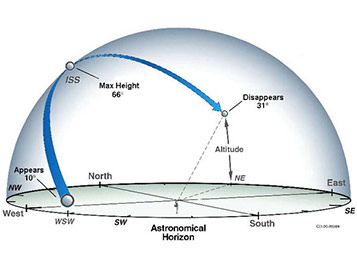If you like the International Space Station and want to see it fly overhead here is how I do it. Go to:
http://spotthestation.nasa.gov/index.cfm
and sign up for "Spot The Station" alerts. Spot The Station is available worldwide to anyone with an email account or SMS-enabled phone. Several times a week, Mission Control at NASA’s Johnson Space Center in Houston, TX, determines sighting opportunities for over 6,700 locations worldwide. If your specific city or town isn’t listed, pick one that is fairly close to you. The space station is visible for a long distance around each of the listed locations. A complete list of all possible space station sightings is available at Spot The Station’s location sightings pages. The alerts look like this:

Then you just need to go outside and look for something that looks like a really bright star, or planet, cruising across the sky really fast from the proper direction and elevation and that will be it. The station is about 258 miles up and orbits at about 17,000 miles per hour. Have fun!
Time is when the sighting opportunity will begin in your local time zone. All sightings will occur within a few hours before or after sunrise or sunset. This is the optimum viewing period as the sun reflects off the space station and contrasts against the darker sky.
Visible is the maximum time period the space station is visible before crossing back below the horizon.
Max Height is measured in degrees (also known as elevation). It represents the height of the space station from the horizon in the night sky. The horizon is at zero degrees, and directly overhead is ninety degrees. If you hold your fist at arm’s length and place your fist resting on the horizon, the top will be about 10 degrees.
Appears is the location in the sky where the station will be visible first. This value, like maximum height, also is measured in degrees from the horizon. The letters represent compass directions -- N is north, WNW is west by northwest, and so on.
Disappears represents where in the night sky the International Space Station will leave your field of view.

---

http://spotthestation.nasa.gov/index.cfm
and sign up for "Spot The Station" alerts. Spot The Station is available worldwide to anyone with an email account or SMS-enabled phone. Several times a week, Mission Control at NASA’s Johnson Space Center in Houston, TX, determines sighting opportunities for over 6,700 locations worldwide. If your specific city or town isn’t listed, pick one that is fairly close to you. The space station is visible for a long distance around each of the listed locations. A complete list of all possible space station sightings is available at Spot The Station’s location sightings pages. The alerts look like this:

Then you just need to go outside and look for something that looks like a really bright star, or planet, cruising across the sky really fast from the proper direction and elevation and that will be it. The station is about 258 miles up and orbits at about 17,000 miles per hour. Have fun!
Time is when the sighting opportunity will begin in your local time zone. All sightings will occur within a few hours before or after sunrise or sunset. This is the optimum viewing period as the sun reflects off the space station and contrasts against the darker sky.
Visible is the maximum time period the space station is visible before crossing back below the horizon.
Max Height is measured in degrees (also known as elevation). It represents the height of the space station from the horizon in the night sky. The horizon is at zero degrees, and directly overhead is ninety degrees. If you hold your fist at arm’s length and place your fist resting on the horizon, the top will be about 10 degrees.
Appears is the location in the sky where the station will be visible first. This value, like maximum height, also is measured in degrees from the horizon. The letters represent compass directions -- N is north, WNW is west by northwest, and so on.
Disappears represents where in the night sky the International Space Station will leave your field of view.

---

